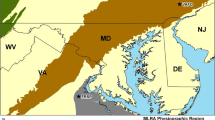Abstract
National Wetland Inventory (NWI) maps are widely used in the United States but have not been independently evaluated in the Great Lakes region nor in forested areas with level topography. Field data from 148 plots in the Hiawatha National Forest ecological classification and inventory program were combined with an additional review to evaluate NWI mapping accuracy. NWI maps were over 90% accurate in identifying uplands and jurisdictional wetlands. All nonforested wetlands were identified correctly. Uplands were correctly identified 96.9% of the time. The lowest level of accuracy, 90.7%, was achieved in identifying forested wetlands. The most common error was the NWI classification of wetlands on the AuGres soil series, a somewhat poorly drained upland soil that often occurs in complexes with wetland soils in the region. Forested wetlands with a cover type similar to adjacent uplands were also a source of error on NWI maps. The already high accuracy of NWI maps could be improved by the mapping of wetland-upland complexes, a development corresponding to the increased mapping of hydric-nonhydric soil complexes in area soil surveys. The continued refinement of regional lists of hydrophytic vegetation is supported by indicator status discrepancies between an extensive Hiawatha National Forest database and the current NWI list for the region.
Similar content being viewed by others
Literature cited
Albert, D. 1995. Regional landscape ecosystems of Michigan, Minnesota, and Wisconsin: a working map and classification. U.S. Department of Agriculture, Forest Service, North Central Forest Experiment Station, St. Paul, MN, USA. General Technical Report NC-178.
Berndt, L. W. 1977. Soil Survey of Delta county and Hiawatha National Forest of Alger and Schoolcraft counties, Michigan. U.S. Department of Agriculture Soil Conservation Service and Forest Service. Washington D.C., USA.
Cowardin, L. M. and F. C. Golet. 1995. U. S. Fish and Wildlife Service 1979 wetland classification: a review. Vegetatio 118:139–152.
Cowardin, L. M., V. Carter, F. C. Golet, and E. T. LaRoe. 1979. Classification of wetlands and deepwater habitats of the United States. U.S. Fish and Wildlife Service, Washington, DC, USA. FWS/OBS-79/31.
Crowley, S., C. O’Brien, and S. Shea. 1988. Results of the wetland study and the 1988 draft wetland rules. Agency of Natural Resources, Division of Water Quality, Waterbury, VT, USA.
Dahl, T. E. 1992. Wetland status and trends—the link to remote sensing. p. 221–230. In Proceedings of Remote Sensing & Natural Resource Management, The Fourth Forest Service Remote Sensing Applications Conference, Orlando, FL, USA.
Dahl, T. E. 1993. Use of hydric soils in national programs of the U.S. Fish and Wildlife Service. p. 348. In Agronomy Abstracts, American Society of Agronomy, Madison, WI, USA.
Environmental Laboratory. 1987. Corps of Engineers wetland delineation manual. U.S. Army Engineer Waterways Experiment Station, Vicksburg, MS, USA. Technical Report Y-87-1.
Federal Interagency Committee for Wetland Delineation. 1989. Federal manual for identifying and delineating jurisdictional wetlands. U.S. Army Corps of Engineers, U.S. Environmental Protection Agency, U.S. Fish and Wildlife Service, and U.S. Department of Agriculture, Soil Conservation Service, Washington, DC, USA.
Gillis A. M. 1996. Make sure you have a good map. Bioscience 46:808–809.
Kudray, G. M. 1995. Hiawatha National Forest (western half) landtype and landtype phase key. May 1996 draft. Hiawatha National Forest, Escanaba, MI, USA.
Kuzila, M. S., D. C. Rundquist, and J. A. Green. 1991. Methods for estimating wetland loss: the Rainbasin region of Nebraska, 1927–1981. Journal of Soil and Water Conservation 46:441–445.
National Research Council. 1995. Wetlands Characteristics and Boundaries. National Academy Press Washington, DC, USA.
Nichols, C. 1994. Map accuracy of National Wetlands Inventory Maps for areas subject to Maine Land Use Regulation Commission Jurisdiction. U.S. Fish and Wildlife Service, Hadley, ME, USA. Ecological Services Report R5-94/6.
Reed, P. B. Jr. 1997. National list of plant species that occur in wetlands: 1996 National Summary. U.S. Fish and Wildlife Service, St Petersburg, FL, USA.
Stolt, M. H. and J. C. Baker. 1995. Evaluation of National Wetland Inventory Maps to inventory wetlands in the southern Blue Ridge of Virginia. Wetlands 15:346–353.
Swartwout, D. J., W. P. MacConnell, and J. T. Finn. 1981. An evaluation of the National Wetlands Inventory in Massachusetts. p. 685–691. In Proceedings of the In-Place Resource Inventories Workshop, Orono, ME, USA.
Tiner, R. W. 1997a. NWI maps—basic information on the nation’s wetlands. Bioscience 47:269.
Tiner, R. W. 1997b. NWI maps: what they tell us. National Wetlands Newsletter 19:7–12.
Tiner, R. W. Jr., 1990. Use of high-altitude aerial photography for inventorying forested wetlands in the United States. Forest Ecology and Management 33/34:593–604.
U. S. Department of Agriculture Soil Conservation Service. 1993. Hydric soils of Michigan. U.S. Department of Agriculture Soil Conservation Service, East Lansing, MI, USA.
Wilen, B. O. and M. K. Bates. 1995. The U.S. Fish and Wildlife Service’s National Wetland Inventory project. Vegetatio 118:153–169.
Wilen, B. O. and H. R. Pywell. 1981. National Wetlands Inventory map production. p. 189–190. In Proceedings of the In-Place Resource Inventories Workshop, Oronto, ME, USA.
Author information
Authors and Affiliations
Rights and permissions
About this article
Cite this article
Kudray, G.M., Gale, M.R. Evaluation of National Wetland Inventory maps in a heavily forested region in the upper Great Lakes. Wetlands 20, 581–587 (2000). https://doi.org/10.1672/0277-5212(2000)020[0581:EONWIM]2.0.CO;2
Received:
Revised:
Accepted:
Issue Date:
DOI: https://doi.org/10.1672/0277-5212(2000)020[0581:EONWIM]2.0.CO;2




